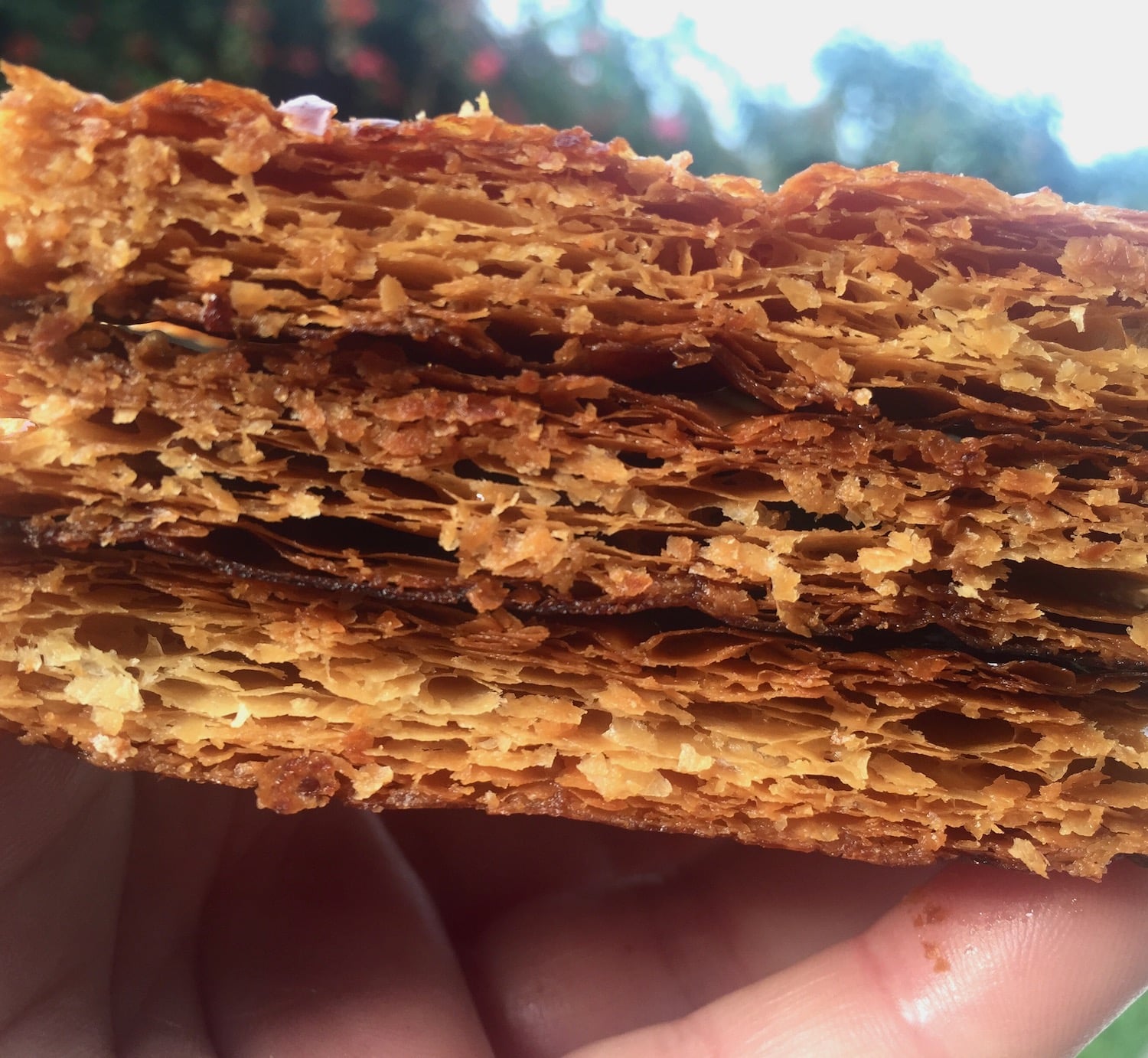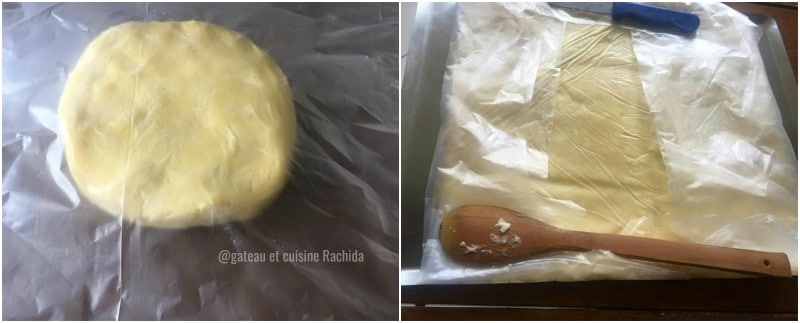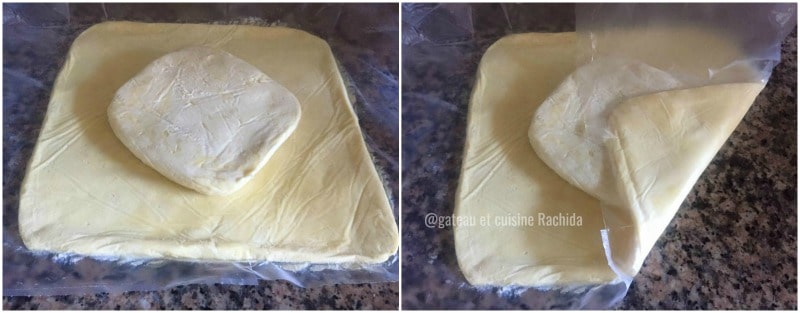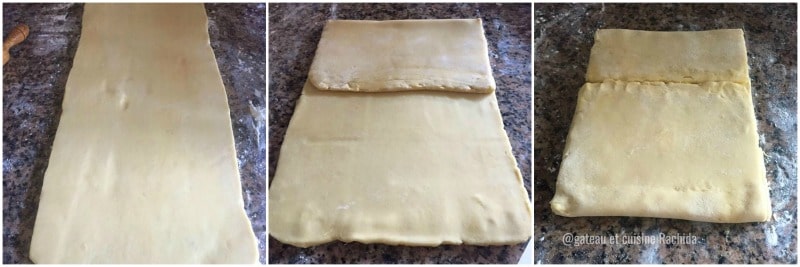
Inverted puff pastry, less known than classic puff pastry, is very famous for making certain recipes, especially galette des rois (French King cake). It creates a light and well-developed flaky texture. If you’re wondering what makes it different from other puff pastries, it’s not the number of folds but rather the preparation method.
-
- Classic puff pastry is made from a dough (the pastry that will envelop the butter) and butter. The butter is inserted into the dough, then the pastry is rolled out and folded in 3 (single turn) or folded like a wallet (double turn), this process is called lamination. Between each turn, the dough is left to rest in a cool place to prevent the butter from melting and mixing with the dough.
- Inverted puff pastry gets its name from the method used in its preparation: in this process, the détrempe is wrapped in kneaded butter (beurre manié), a mixture of butter and flour. This method is the opposite of classic puff pastry, where the butter is enclosed inside the détrempe. This recipe and method are those of Chef Christophe Felder, from his book Pâtisserie.
The laminating is then done in the same way, with successive single or double folds. As the butter is on the outside, the dough can be more difficult to handle, making it necessary to flour the work surface frequently.
- The quick puff pastry is the simplest version. It is made by directly incorporating cold butter into the dough. It requires little to no resting time and requires fewer turns, usually three at most. This method saves time while still achieving good layering.
Table of Contents
Which butter for laminating?
The perfect butter for lamination is a dry butter with 84% fat content, which melts more slowly and offers excellent plasticity. Lamination butters such as Lescure, Échiré, or Isigny are ideal and can be purchased online. However, PDO butters like Charentes-Poitou or others with 82% fat content also work well, but you’ll need to extend the resting times between folds for the best results.
Ingredients:
NB: You can find the printable recipe card at the end of the article.
Butter Dough (Kneaded Butter)
- 375 g of softened butter, preferably special lamination butter or with 82% fat content (13.2 oz).
- 150 g of flour, preferably T45 (I used all-purpose flour) ( 5.3 oz).
Main dough-détrempe
- 350 g of flour, preferably T55 (I used all-purpose flour) (12.3 oz).
- 110 g melted butter (4 oz)
- 1 teaspoon salt
- 1 teaspoon vinegar (optional)
- 150 ml water (5.3 oz)
Preparation steps :
Butter Dough (Kneaded butter)
1. Work the soft butter and sifted flour with a wooden spoon until you get a ball of dough. You can use a stand mixer with the paddle attachment and work at speed 2 until you get a homogeneous dough.
2. Lightly smooth the dough by rolling it on the work surface.
3. Place the dough between two sheets of parchment paper and flatten it into a square about 5 mm thick (0.2 inches). Wrap and refrigerate for 1 hour 30 minutes.

Main dough and Butter Dough
Main Dough- Détrempe :
1. Melt the butter and let it cool.
2. Dissolve the salt in the water and vinegar.
3. In the bowl of the stand mixer, fitted with the dough hook, mix the flour and water until you get a dough that starts to come together.
4. Add the cooled melted butter and mix until you get a homogeneous dough. Don’t overwork the dough to avoid making it elastic.
5. Transfer the dough to the work surface and roll it on the work surface to obtain a smooth ball.
6. Do not knead to avoid making the dough elastic, as elastic dough is more difficult to roll out. Place the dough between two sheets of parchment paper and roll it out into a square about 2 cm thick( 0.8 inches). Wrap and refrigerate for 1h30. 5. After 1h30 of resting in the refrigerator, start enclosing the dough (détrempe) in the large square of butter dough.
Note: This method of enclosing the détrempe like an envelope corresponds to the classic technique. I will also suggest a more recent method, similar to the one used for classic puff pastry.

détrempe and butter dough
7. Use plastic wrap to fold one corner of the large square of butter dough towards the center of the small square of dough.
8. Then fold the opposite corner towards the middle in the same manner.
9. Bring the third corner of the square towards the center of the small square. If the butter block sticks or tears slightly, seal the damaged areas by gently pressing.
10. Completely enclose the small square of dough in the butter dough by folding down the last corner.
11. Wrap and refrigerate for at least 30 minutes to firm up.

Laminating :
1. Lightly flour the work surface as well as the top of the dough to prevent the rolling pin from sticking.
2. Roll out the dough into a rectangle about 1 cm (0.4 inches) thick. Make sure to flour the work surface and the rolling pin well the first time, as the dough may stick. The dough should slide easily without sticking.
Note: Flouring means lightly sprinkling with flour to prevent the dough from sticking. When rolling out, maintain the rectangular shape, making sure not to exceed the edges. Roll out lengthwise while gently expanding to achieve an even thickness and not too thick. The rolling pin should never go beyond the edges of the dough.
3. Fold one-third of the dough over itself, then fold the remaining two-thirds in half to bring the two edges together. They should not overlap. You can see what it looks like in the image below.

Inverted puff pastry double fold
Note: You can also do the double fold like this:
- Fold the rectangle of dough in half to mark the center as a reference, then unfold. You can also simply mark the center using a ruler.
- Fold the upper side to the center.
- Then bring the lower side to join the upper side at the center. This is what it looks like up close.
4. Then fold it all in half, like a wallet, as shown in the photo below.
You have just completed 1 double fold, also called a wallet turn. Wrap this dough and let it rest in the refrigerator for 1 hour or more.
5. After 1 hour of refrigeration, take out the dough and give it a quarter turn to the right, the folds of the wallet (or opening) should always be oriented towards your right.
6. Lightly tap the bottom and top of the dough with the rolling pin, as illustrated in the photo.

wallet fold
7. Roll out the dough into a long rectangle to make the 2nd double fold following steps 3, 4, 5 and 6 above.
8. Once this 2nd double fold is completed, wrap the dough and let it rest in the refrigerator for 1 hour or more.
9. After 1 hour of refrigeration, take out the dough to perform a final single fold. Proceed as follows, as shown in the image at step 6.
10. Give the dough a quarter turn to the right, making sure that the wallet folds (opening) are always on your right.
11. Tap the bottom and top of the dough with the rolling pin, as illustrated, then roll it out into a long rectangle of about 65 cm by 20 cm (25.6/7.9 inches).
12. To make the single turn/fold, fold the rectangle in 3:
13. Fold the upper 1/3 of the dough and fold the lower side over it. The puff pastry is ready.

1 single fold
There you have it, your inverted puff pastry is ready. Film it until you use it. Chill for at least 2 h if you want to use it the same day. Make a quarter turn and cut in half before lowering.

Homemade Inverse Puff Pastry Recipe
INGREDIENTS
Butter Dough (kneaded butter)
- 375 g softened butter preferably special lamination butter or with 82% fat content (13.2 oz).
- 150 g flour preferably T45 (I used all-purpose flour) ( 5.3 oz).
Main dough-détrempe
- 350 g flour preferably T55 (I used all-purpose flour) (12.3 oz).
- 110 g melted butter (4 oz)
- 1 teaspoon salt
- 1 teaspoon vinegar optional
- 150 ml water (5.3 oz)
PREPARATION
Butter Dough (Kneaded butter)
- I recommend checking out the steps in images in the article.
- Work the soft butter and sifted flour with a wooden spoon until you get a ball of dough. You can use a stand mixer with the paddle attachment and work at speed 2 until you get a homogeneous dough.
- Lightly smooth the dough by rolling it on the work surface.
- Place the dough between two sheets of parchment paper and flatten it into a square about 5 mm thick (0.2 inches). Wrap and refrigerate for 1 hour 30 minutes.
Main Dough -Détrempe:
- Melt the butter and let it cool.
- Dissolve the salt in the water and vinegar.
- In the bowl of the stand mixer, fitted with the dough hook, mix the flour and water until you get a dough that starts to come together.
- Add the cooled melted butter and mix until you get a homogeneous dough. Don't overwork the dough to avoid making it elastic.
- Transfer the dough to the work surface and roll it on the work surface to obtain a smooth ball.
- Do not knead to avoid making the dough elastic, as elastic dough is more difficult to roll out. Place the dough between two sheets of parchment paper and roll it out into a square about 2 cm thick( 0.8 inches). Wrap and refrigerate for 1h30.
- After 1h30 of resting in the refrigerator, start enclosing the dough (détrempe) in the large square of butter dough.
- Note: This method of enclosing the détrempe like an envelope corresponds to the classic technique. I will also suggest a more recent method, similar to the one used for classic puff pastry.
- Use plastic wrap to fold one corner of the large square of butter dough towards the center of the small square of dough.
- Then fold the opposite corner towards the middle in the same manner.
- Bring the third corner of the square towards the center of the small square. If the butter block sticks or tears slightly, seal the damaged areas by gently pressing.
- Completely enclose the small square of dough in the butter dough by folding down the last corner.
- Wrap and refrigerate for at least 30 minutes to firm up.
Laminating :
- Lightly flour the work surface as well as the top of the dough to prevent the rolling pin from sticking.
- Roll out the dough into a rectangle about 1 cm (0.4 inches) thick. Make sure to flour the work surface and the rolling pin well the first time, as the dough may stick. The dough should slide easily without sticking.
- Note: When rolling out, maintain the rectangular shape, making sure not to exceed the edges. Roll out lengthwise while gently expanding to achieve an even thickness and not too thick. The rolling pin should never go beyond the edges of the dough.
- Fold one-third of the dough over itself, then fold the remaining two-thirds in half to bring the two edges together. They should not overlap. You can see what it looks like in the image in the article.
- Note: You can also do the double fold like this:
- Fold the rectangle of dough in half to mark the center as a reference, then unfold. You can also simply mark the center using a ruler. Fold the upper side to the center. Then bring the lower side to join the upper side at the center. Then fold it all in half, like a wallet.
- You have just completed 1 double fold, also called a wallet turn. Wrap this dough and let it rest in the refrigerator for 1 hour or more.
- After 1 hour of refrigeration, take out the dough and give it a quarter turn to the right, the folds of the wallet (or opening) should always be oriented towards your right.
- Lightly tap the bottom and top of the dough with the rolling pin.
- Roll out the dough into a long rectangle to make the 2nd double fold following steps 3, 4, 5 and 6 above.
- Once this 2nd double fold is completed, wrap the dough and let it rest in the refrigerator for 1 hour or more.
- After 1 hour of refrigeration, take out the dough to perform a final single fold. Proceed as follows, as shown in the image at step 6.
- Give the dough a quarter turn to the right, making sure that the wallet folds (opening) are always on your right.
- Tap the bottom and top of the dough with the rolling pin, as illustrated, then roll it out into a long rectangle of about 65 cm by 20 cm (25.6/7.9 inches).
- To make the single turn/fold, fold the rectangle in 3:
- Fold the upper 1/3 of the dough and fold the lower side over it. The puff pastry is ready.
- There you have it, your inverted puff pastry is ready. Film it until you use it. Chill for at least 2 h if you want to use it the same day. Make a quarter turn and cut in half before lowering.
Thank you for visiting my blog and for your comments.
You can also follow me on my youtube channel
